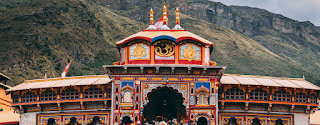5 BEST PLACES IN BADRINATH
5 DIVINE PLACES TO VISIT IN BADRINATH
Mystery and mythology interweave the places to visit in Badrinath in Uttarakhand, India. It constitutes one of the four heavenly abodes (Char Dham) of the Hindu pilgrimage circuits in India. You cannot visit the pilgrimage in the winters. The reason being Lord Badrinath resides in the Narsingh Temple at Joshimath at that time. The high priests determine the opening and closing dates of the shrines of the Char Dham. It is important to be aware of the time one can embark on the journey to check out the places to visit in Badrinath Dham.
The Route
We had planned to cover all the places around Badrinath in a single day. We started from our hotel in Joshimath at around 7 am. It was November and extremely cold outdoors. Wrapped in multiple layers of woolen sweater and a bomber jacket, we set off in our vehicle.
As our car drove ahead, the character of the mountains kept changing. All around now, the grey rocks broke the blue skyline in craggy peaks. At around midway of this journey comes Govindghat. It is the starting point for trekking to Sri Hemkund Sahib and Valley of Flowers.
Tapt Kund
In an hour’s time, we reached Badrinath. Of the four “Dhams”, Badrinath and Gangotri are directly accessible by motorable roads. There is a thermal spring right at the entrance of the shrine. Bathing in the hot waters of Tapt Kund is a ritual. A common belief lies in the healing properties of sulphur in the water and the faith of having the goodness of absolving devotees of all sins. Tapt Kund is one of the holy places to visit in Badrinath.
Enclosures are made for the convenience of women as well. We walked across the footbridge over the river Alaknanda. The absolute beauty of the mountains in the backdrop and the vividly painted temple in the forefront overwhelmed us.
The Badrinath Temple
Hindu scriptures state Lord Hari undertook severe penance. His divine consort Mata Mahalaxmi turned herself into a Badri tree (a kind of a berry), to save him from turbulent weather. The reason people worship Lord Narayan as the Lord of Badri – Badrinath.
The temple, at an altitude of 3133 metres above sea level, is one of the Panch (Five) Badri. The mountains soar upwards as if determined to touch the heavens. It is easy to comprehend why mythology asserts the Gods around these snow-capped peaks. The temple is one of the religious places to visit in Badrinath.
You will find long queues of devotees lined up for “darshan” (worshipping the Lord) of the deity. Shops in the courtyard in front of the main temple sell small balls of sugar (Nakul-Dana) and other items to offer to Lord Badri.
The temple facade is built of stone and has arched windows. It was in the 16th century that a Garhwal King got a temple erected to house the statue of God. The present structure is the result of plenty of restorations repairing the damages caused by avalanches and earthquakes. Lord Vishnu is worshipped in a Shalagram (black stone) idol; sitting in a meditative pose surrounded by idols of other Gods like Ganesha, Garuda, Kuber and more. After we entered the dimly lit sanctum and treated our eyes with the view of Badrinath, a deep sense of divinity filled our hearts and minds. An abundance of spiritual aura seemed to ooze out of every corner. It seemed that His genuine holiness was connecting with us in the most tangible way possible. Fifteen more idols are worshipped around the temple.
Charanpaduka
About three km from the main temple, there is a place with imprints of Lord Vishnu’s feet. Narrow and steep village road leads the way to this place and it takes around an hour to reach the spot. The calm of the region and the mesmerizing view of the glaciers is a treat for the eyes to behold! It is one of the divine places to visit in Badrinath. At around 300 metres from the Badrinath Temple, signboard asserted the birthplace of Badri Narayan. Google doesn’t mention this place in its suggestions, yet we decided to have a look.
According to a legend, Lord Shiva and Parvati used to reside in the temple premise. One day, they had found a child here, whom they lovingly carried to their house. Keeping the child at home, God and his consort went to take a bath in the river. On their return, they found all doors of the temple locked from inside. Badrinarayan appeared in his true form and asked them to move to Kedarnath. We walked through the lanes of the town of Badrinath, crossing over a small bridge built over a stream. We reached a spot with a raised mass of uneven rock, black in colour (much like the stone that the deity Badrinath is made of), with a signboard chronicling the legend.


Comments
Post a Comment